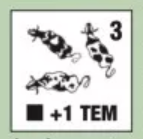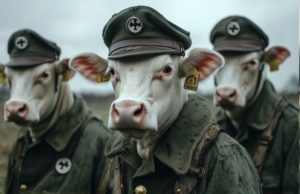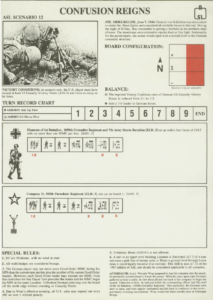Publisher/Date:
Multi-Man Publishing (2023)
Product Type:
HASL/Historical Module
Country of Origin:
United States
Contents:
3 22" x 30.5" historical maps on thin semi-gloss paper; 1 die-cut countersheet (with 180 1/2" counters and 64 5/8" counters, for a total of 244 counters); 11 scenarios on cardstock; 3 campaign games; 28 pages rules (Chapter SM).
Drop Zone: Sainte-Mère-Église (hereinafter SME) is a smallish (except in map area) historical module published by MMP in early 2023. It focuses on fighting in and around the Normandy village of Sainte-Mère-Église between paratroopers of the U.S. 82nd Airborne Division and several German units on June 6-7, 1944. It is the first of a planned three modules about fighting in this area, though future modules may depend on the sales and popularity of this one. The module’s name indicates that MMP did not learn the main lesson of Hakkaa Päälle!, which is “Stick to titles that use the English alphabet.” SME is the first official HASL or “Historical Study” on Normandy to be published since 1997’s Pegasus Bridge [official historical modules, including this one, have covered Stalingrad (3), Battle of the Bulge (2), Normandy (2), Tarawa (1), Operation Market-Garden (1), Guadalcanal (1), Operation Veritable (1), Budapest (1), Operation Nordwind (1), Manila (1), and France 1940 (1); this does not include Chapter Z subjects, which are not full modules].
The centerpiece of SME is its historical map, which is a little unusual, in that it consists of three full-sized (22″ x 30.5″) maps that combine together in a row lengthwise, creating a large and very long map area–too long for many gaming tables at about 88″ or so (taking into account overlapping hexrows). That’s more than 7 feet long! It will need an 96″ x 30″ folding table or equivalent. However, the full version of the map is only needed for one campaign game. Hexes on the maps are not 1″ in size, as in Red Barricades, but smaller, closer to geoboard size. The maps are printed on thin, semi-gloss paper, which Desperation Morale does not like as much as matte paper of a thicker stock. The SME map depicts the hedgerow terrain just a bit south of the Normandy beaches. As such, the maps are more or less flat and dominated by hedgerows Essentially, going from north to south, the terrain consists of a flat area that contains little but hedgerows, orchards, a stream and irrigation canals, followed by a huge, map-edge to map-edge level-1 hill that takes up the rest of the map. Basically this is a relatively small rise in terrain that functions here like a huge low plateau. This “hill,” which has its own hedgerows and orchards, crosses over 3-5 hexrows into the center map. The center map contains more hedgerow and orchard terrain surrounding the village of Sainte-Mère-Église itself, a collection of around 50 mostly 1- or 2-hex stone buildings centered around a town square. Oddly, many of these buildings are in a -1 depression/valley. South of the village, open areas get a little more expansive and there’s a long gully. Continuing south, the final map starts with more hedgerows and orchards, along with some grain and a couple of small hamlets. South of the hamlet is a fairly large, flat level-1 hill mass, then more farm land, with grain, hedgerows and an irrigation ditch system.
Though there’s an abundance of map area, the terrain is not very striking; it certainly does not offer any of the interesting features of Festung Budapest, or dynamic terrain of Kampfgruppe Peiper. Because height variations are few, while hedgerows cover the map, there will be a lot of same-level firing, with defenders behind hedgerows (except within the villages). One part of the map area looks a lot like another part of the map area. Between the open ground, hedgerows, orchards, and the occasional patch of woods, it’s a very green map–so much so that the map artists added brown, path-like markings to the openings that sometimes occur in hedgerow hexsides, to make them a little bit more visible. Even the big level-1 hill masses blend into the green, in part because they seem to have a faded or washed-out brown hue, and do not stand out at all. There seems to be considerably more contrast between the level-0 and level-1 terrain in Operation Veritable or the Dinant HASL in Croix De Guerre than in this module. It’s not clear why this decision was made, but it would have been nice if the level-1 terrain were more vivid and noticeable.
 SME comes with three maps but only one countersheet; it’s not a high counter density situation. Many of the counters are markers, including 40 control markers, burnt-out wrecks, foxholes, wall advantage counters (given that this module is all “wall”), No Move counters (boo!), and so forth. There are also some Glider counters, 10 AFVs, some extra paratrooper counters, MGs, and leaders, and some extra German infantry, etc., as well. The most interesting new counter type is a new German squad type, a 5–3-7 2nd-line squad, dubbed “Sturm MMC.” Luckily, this is not intended as a new squad type for the whole ASL system, but rather to represent a specific battalion-sized army-level attachment consisting of troops loaded with weapons to be used for attacks or counterattacks.
SME comes with three maps but only one countersheet; it’s not a high counter density situation. Many of the counters are markers, including 40 control markers, burnt-out wrecks, foxholes, wall advantage counters (given that this module is all “wall”), No Move counters (boo!), and so forth. There are also some Glider counters, 10 AFVs, some extra paratrooper counters, MGs, and leaders, and some extra German infantry, etc., as well. The most interesting new counter type is a new German squad type, a 5–3-7 2nd-line squad, dubbed “Sturm MMC.” Luckily, this is not intended as a new squad type for the whole ASL system, but rather to represent a specific battalion-sized army-level attachment consisting of troops loaded with weapons to be used for attacks or counterattacks.  There is also a single “double roadblock” marker, designed for blocking two hexsides’ worth of roads at once, plus the most noteworthy new counter of all: the Cows counter. There are three Cow counters in the module, which represents groups of cows (calling them a herd seems grandiose) that people can move around (even getting cover from them). It’s about time that ASL finally started simulating beefkrieg.
There is also a single “double roadblock” marker, designed for blocking two hexsides’ worth of roads at once, plus the most noteworthy new counter of all: the Cows counter. There are three Cow counters in the module, which represents groups of cows (calling them a herd seems grandiose) that people can move around (even getting cover from them). It’s about time that ASL finally started simulating beefkrieg.
 SME comes with 11 scenarios, all but one of which use part (sometimes a large portion, sometimes a much smaller portion) of a single map. A number of the scenarios depict action that are essentially HASL versions of previously-published scenarios. For example, SM9 (Confusion Reigns) is not an original scenario but a remake of Paratrooper’s scenario 12 (Confusion Reigns). The historical description is the same, the key SSRs are the same, the OBs are very similar (more so for the Americans than the Germans), and the VC are almost identical. Five of the scenarios of SME are such “adaptations,” meaning that there are only six wholly original scenarios in the module. This is rather disappointing; it would have been more interesting if designer Ken Dunn had taken the historical situations and simply given them his own ASL take, designing new scenarios based on those actions rather than adapting the scenarios designed by others. This is especially so as several of these adaptations contain “straitjacket” SSRs that severely limit what units can do. Such SSRs were not uncommon in early ASL releases but, as they were unpopular, have largely been abandoned by later scenario designers. However, here they see new life.
SME comes with 11 scenarios, all but one of which use part (sometimes a large portion, sometimes a much smaller portion) of a single map. A number of the scenarios depict action that are essentially HASL versions of previously-published scenarios. For example, SM9 (Confusion Reigns) is not an original scenario but a remake of Paratrooper’s scenario 12 (Confusion Reigns). The historical description is the same, the key SSRs are the same, the OBs are very similar (more so for the Americans than the Germans), and the VC are almost identical. Five of the scenarios of SME are such “adaptations,” meaning that there are only six wholly original scenarios in the module. This is rather disappointing; it would have been more interesting if designer Ken Dunn had taken the historical situations and simply given them his own ASL take, designing new scenarios based on those actions rather than adapting the scenarios designed by others. This is especially so as several of these adaptations contain “straitjacket” SSRs that severely limit what units can do. Such SSRs were not uncommon in early ASL releases but, as they were unpopular, have largely been abandoned by later scenario designers. However, here they see new life.
The 11 scenarios not surprisingly tend to be smaller in size. There are three large scenarios, three medium-sized scenarios, and five small scenarios. One scenario uses Night rules (see below), while no scenarios use OBA or Air Support rules. One scenario, SM5 (Raff’s Distress), is not a digestive condition but rather a scenario depicting a glider landing.
Another of the original scenarios, SM11 (Ridgway’s Mission) is a monster historical scenario. It doesn’t use all three maps but does use all of one map and most of a second–which is still a considerable map area. The scenario depicts the major German attempt to retake Sainte-Mère-Église from both the north and the south on D-Day. The defending paratroopers have 28.5 squads, elite but lightly armed, and 2 guns. The attacking Germans–generally poor quality troopers–have 50 squads, 8 AFVs, 1 Gun, and–you guessed it–3 Cows. To win, the Germans must control two building hexes straddling a key road and achieve one of four possible victory conditions, including an immediate win VC, a VC determined by the end of Turn 9 (of a possible 18), and two VC determined at the end of Turn 18. The final two turns (only) of the scenario use Night rules.
SME comes with 28 pages of rules, most of which deal with 3 included campaign games. General rules cover the German Sturm MMC and the Cows, as well as a couple of terrain features, including a single hex consisting of both a building and a road running through the center of the hex. This unusual terrain feature immediately raised a number of questions for Your Humble Author that did not seem clearly to be covered in the rules for the feature. There is also a rule designed to allow fire down roads running through alternate hex grains. At only three pages, including examples and illustrations, the rules load for SME is light, allowing players easily to jump into a scenario or a campaign game.
The three campaign games are all relatively small, both in terms of time and number of units. CGI (Together We Will Raise This Flag) simulates the events of June 6. It consists of 3 CG dates: a morning scenario, an afternoon scenario, and a night scenario. It uses the center map and part of the southern map. CG2 (Liberation Road) depicts the actions of June 7. It features 3 CG dates (dawn, afternoon, and evening), with a possible 4th CG date (mid-morning) sandwiched between the first two at the option of the American player. This campaign game uses the northern and center maps. CG3 (Krause and Vandervoort) has 7 CG dates (with a possible 8th, same as above) and uses all three maps. It basically combines the first two campaign games.
Most of the CG rules are the standard Refit Phase rules, although there are some differences, including the use of “Chits,” which may be purchased and saved and used for several possible purchases, including to determine who sets up or goes first in a CG date, or when that date ends. This adds an interesting “meta” aspect to the campaign games. The rules also introduce the idea of secretly-recorded Objective Hexes, the control of which can turn them into Strategic Locations (and thus affect setup areas, etc.). Neither of these new concepts is particularly difficult to grasp.
The campaign game themselves offer only limited choices to players. Players do not have access to lists of Reinforcement Groups, as is standard for almost all official campaign games. Both sides’ ability to purchase units is very limited. In fact, each campaign date has its own specific Purchase Table for each side (or no options at all). Players get only a handful of purchase points (at most) and can only use them in limited ways. For example, for the first campaign date of the first campaign, the American player gets 5 purchase points. He can use them to purchase his leaders (with one set of leaders available for 1PP, a better set for 2PP, and the best set for 3PP), his SW (again, with 1PP, 2PP, and 3PP options), his vehicles/guns (an AT gun and a jeep for 1PP or two AT guns/jeeps for 2PP), and his “Special” additions: 1PP buys a 7-0, 6 concealment counters, and +1 SAN; 2PP buys an 8-0, a 7-4-7, 8 concealment counters, and a roadblock; and 3PP buys 2 x 7-4-7, a MMG, 10 concealment counters, and a roadblock. The German player has similar options. For the second CG date, both players have completely different purchase charts, while the third CG date also has its own charts (centered primarily around Night rules options). The second campaign game basically allows players no purchases, but either specifies exact reinforcements and accoutrements or determines them randomly. The third campaign game, which is a combination of the first two, essentially repeats the options of the first two.
The very limited purchase options may be a turn-off for some ASLers, for whom the purchases are one of the most fun parts of campaigns, but they may make these campaign games easier for players playing their first campaign game. Because the purchase options are so limited, players simply don’t have to anguish very much over what the “optimal” purchases might be (the way they might in a Red Barricades campaign game), but instead can concentrate on learning and mastering the refit rules–something that will serve them well for any campaign games from other modules they might try in the future. The generally low counter densities, short campaign lengths, and lack of complex terrain situations (aside from hedgerows, of course) also serve beginners well.
Taking every element together, SME is likely to appeal most to fans of airborne units (or elite units in general, although the German forces are definitely not so elite), to gamers fascinated with Normandy, and to ASLers trying to get into campaign games. For others, the lack of interesting terrain, the small number of original scenarios, and the lack of options for the campaign games might make this product less enticing.
Leave A Reply